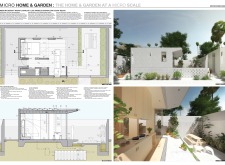5 key facts about this project
Innovative Utilization of Space
One of the distinct features of this project is its intelligent layout that combines private and communal areas. The interior includes compact yet functional living spaces, a combined kitchen and dining area, and multi-purpose rooms that adapt to varying resident needs. Large windows and sliding doors are strategically placed to bridge indoor and outdoor environments, enhancing natural light and encouraging access to community gardens. This configuration not only optimizes the spatial footprint but also creates a sense of openness and connection with nature.
Sustainability and Community Integration
The design emphasizes sustainable practices and community integration, incorporating elements such as rainwater harvesting systems and drought-resistant landscaping. Utilizing low-VOC materials, the project minimizes the environmental impact and promotes a healthier indoor atmosphere. The communal gardens serve as green spaces for residents to gather, fostering social interaction and community spirit. This focus on outdoor living areas distinguishes the Micro Home & Garden from typical housing projects, creating a unique community-oriented approach to urban micro-living.
Technical Features and Material Choices
The architectural design thoughtfully integrates durable construction materials to support longevity and resilience. Key materials include cast-in-place concrete for structural integrity, precast concrete panels for aesthetic façade enhancement, and engineered wood for warmth in living spaces. The careful selection of materials addresses both functional and aesthetic aspects, ensuring the building is appealing while meeting performance requirements. This meticulous attention to materiality and design detail reflects a broader commitment to quality in urban architecture.
For a more comprehensive understanding of the project, readers are encouraged to explore the architectural plans and sections. Reviewing these elements provides deeper insights into the design strategies and architectural ideas implemented throughout the Micro Home & Garden project.























